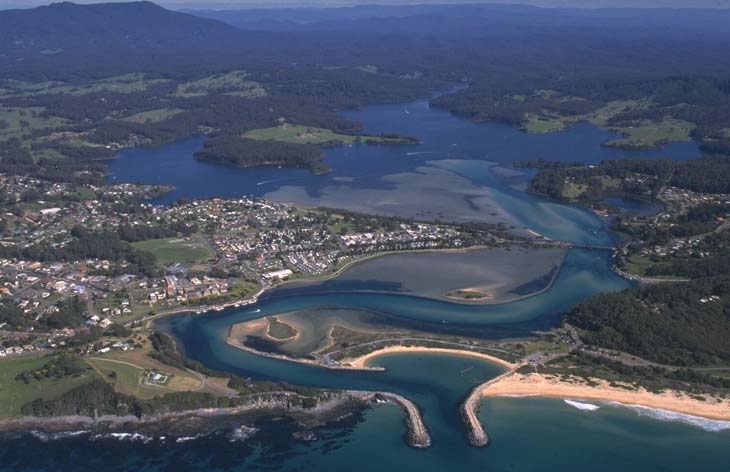Wagonga Inlet is an estuary located on the south coast of New South Wales with the township of Narooma situated around it. The estuary is classed as a lake with an open, trained entrance.
Tributaries that flow into Wagonga Inlet are the Billa Bilba, Burrimbidgee and Punkally creeks. The inlet contains important habitat for fish, birds and plants. It also supports wetlands, mangrove forests, a sand spit and seagrass beds.
Wagonga Inlet is popular for recreational activities such as fishing and enables access to Montague Island.
Water quality report card
As part of our water quality monitoring program we assess the water quality and ecosystem health of an estuary using a range of relevant indicators. We sample a subset of the estuaries between Wollongong and the Victorian border every 3 years. The most recent sampling in Wagonga Inlet was completed over the 2020–21 summer, when 3 sites were sampled on a monthly basis.
This report card represents 2 water quality indicators that we routinely measure: the amount of algae present and water clarity. Low levels of these 2 indicators equate with good water quality.
The report card shows the condition of the estuary was excellent with:
- algae abundance graded excellent (A)
- water clarity graded excellent (A)
- overall estuary health graded excellent (A).
Grades for algae, water clarity and overall are represented as:
- A – excellent
- B – good
- C – fair
- D – poor
- E – very poor.
Go to estuary report cards to find out what each grade means, read our sampling, data analysis and reporting protocols, and find out how we calculate these grades.
We have monitored water quality in Wagonga Inlet since 2011. This table shows the water quality grades for this estuary over that time.
| Year | Algae | Water clarity | Overall grade |
|---|---|---|---|
| 2011–12 | A | A | A |
| 2017–18 | A | A | A |
| 2018–19 | A | A | A |
| 2019–20 | A | A | A |
Physical characteristics
| Estuary type | Lake |
|---|---|
| Latitude (ºS) | –36.21 |
| Longitude (ºE) | 150.13 |
| Catchment area (km2) | 93.3 |
| Estuary area (km2) | 6.9 |
| Estuary volume (ML) | 39,101.3 |
| Average depth (m) | 5.7 |
Tidal prism
Tidal prism data is available for this estuary. This tidal prism data was measured in 1986.
| Tide state | Flow (ML) | Local tidal range (m) | Sydney Harbour tidal range (m) |
|---|---|---|---|
| Ebb flow | 6340 | 1.49 | 1.89 |
| Flood flow | 6640 | 1.24 | 1.57 |
Notes: km2 = square kilometres; m = metres; m3 = cubic metres; ML = megalitres.
Water depth and survey data
Bathymetric and coastal topography data for this estuary are available in our data portal.
Land use
The catchment of Wagonga Inlet has relatively low disturbance. Over 80% of the catchment is forested and this includes a portion of Gulaga National Park. Urban and grazing areas around Narooma form about 10% of the catchment.
Wagonga Inlet webcam
The Narooma bar crossing web camera shows real-time video of conditions within the entrance to Wagonga Inlet to help with bar crossing and boat safety.
National and marine parks
- This estuary flows into Batemans Marine Park.
Citizen science projects
- iNaturalist’s Plants of Eurobodalla is a citizen science project that monitors plants found in the Eurobodalla region.
Community involvement
- Eurobodalla Landcare is a volunteer network of 24 Landcare groups on the New South Wales south coast.
- The Coastwatchers Association is a community environmental and conservation group based on the south coast.
Seafood harvest area status
The NSW Food Authority website lists the current status of oyster/shellfish harvest areas.
Local government management
Local councils manage estuaries within their area unless the estuary is attached to a marine park.
Eurobodalla Shire Council manages this estuary, which is also managed as part of Batemans Marine Park.
